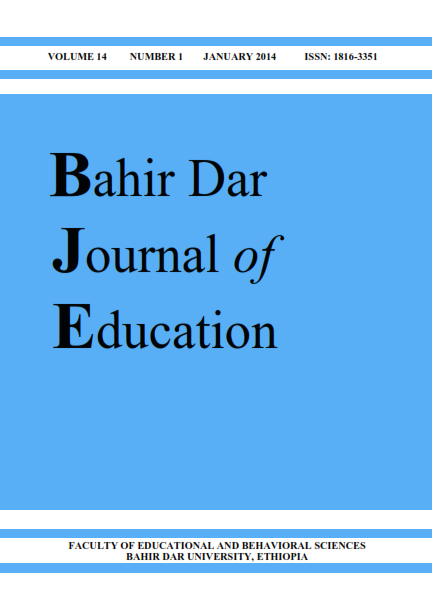The Institutional Impacts of Financial Inadequacy and Financial Inefficiency of Public Universities in Ethiopia: the Case of Bahir Dar 44 University
Abstract
Over the last ten to fifteen years, there have been significant increases in the number of universities and student enrollments in Ethiopia. The numerical gains have increased access to universities and diversified fields of studies. This rapid expansion has not been, however, accompanied by commensurate funding increases. This article briefly presents the financial context (resource allocation, financial adequacy and efficiency) under which public universities operate in Ethiopia. The study employed a qualitative case study approach and used data from a single public university (Bahir Dar University) as a case university to assess and analyze how financial constraints and inefficient use of available resources have been affecting the core institutional missions and operations. Data were gathered using semi-structured interview and document analysis. Overall, the study found that there have been significant financial constraints for the key institutional activities in the case university. On top of this, the institution was poor in its financial management system and as a result unable to efficiently utilize the available resources and the existing degree of financial autonomy. Consequently, the major institutional activities, the quality of teaching learning and research work were seriously affected. Of all, research work was, however, found to be the single most seriously affected mission of the university.References
Albrecht, D. & Ziderman, A. (1995). Financing Higher Education in Developing Countries. The Stanford Series on Education and Policy. The World Bank, Washington, D. C.
Ashkroft, K. (2008). Towards an Implementation Strategy for the Funding Formula of Higher Education in Ethiopia: Report of the Task Force, Ministry of Education, Addis Ababa, Ethiopia.
Avkiran, N.K. (2001). Investigating technical and scale efficiencies of Australian Universities through data envelopment analysis. Socio-Economic Planning Sciences. 35:57-80
Babbie, B. (2007). The Practice of Social Research (Seventh Edition). International Student Edition, Chapman University.
Bahir Dar University (2006). Bahir Dar University Profile. Bahir Dar, Ethiopia.
Creswell, J.W. (2003). Research Design: Qualitative, Quantitative, and Mixed Method Approaches, 2nd Edition. Thousand Oaks, CA: Sage Publications.
Damtew Teferra & Altpach, P. (2004). African Higher Education: Challenges for the 21 Century. Higher Education, Vol. 47, 21-50, the Netherlands.
FDRE (2003). Higher Education Proclamation No. 351/2003. Federal Negarit Gazeta of the Federal democratic Republic of Ethiopia. Addis Ababa, Ethiopia.
FDRE (2009). Higher Education Proclamation No. 650/2009. Federal Negarit Gazeta of the Federal democratic Republic of Ethiopia. Addis Ababa, Ethiopia.
Habtamu Wondimu (2003). Ethiopia: Higher Education Country Profoile. In Damtew Teferra & Altbach, P. (Eds.). African Higher Education: An International Reference Handbook. Bloomington, Indiana University Press.
HESO. (2004). Higher Education Systems Overhaul. Report on Inquiry into Governance, leadership & management in Ethiopia Higher education System.
Johnstone, B. (2002). Challenges of Financial Austerity: Imperatives and Limitations of Revenue Diversification in Higher Education. The Welsh Journal of Education, Vol. 11, No. 1, p. 18-36.
Kibrom Mengistu. (2010). The funding of public higher education institutions in Ethiopia: mechanisms and effects. Unpublished MA thesis. University of Aveiro, Portugal.
Lui, Y. (2007). Revenue Diversification: A Comparison of Russian and Chinese Higher Education. Higher Education in Review, 4, 21-42.
Meek, K. Teichler, U. & Kearney, M. (2009). Higher Education, Research and Innovation: Changing Dynamics. Report on the UNESCO Forum on Higher Education, Research and Knowledge 2001-2009, UNESCP.
Merisotis, J. P. (2003). Higher Education Funding in Ethiopia: An Assessment and Guidance for Next Steps. Institute for Higher Education Policy, Washington, D. C., the World Bank.
Ministry of Education. (2005). Education Sector Development Program (ESDP) III (2005/62010/11). Action Plan, Ministry of Education, AA, Ethiopia.
Ministry of Education .(2002). Ethiopia’s Education Sector Development Program II. Unpublished Policy Document, Addis Ababa, Ethiopia.
OECD (2003). Changing Patterns of Governance in Higher Education. Education Policy Analysis, 2003, pp. 59-78
Reisberg, L. & Rumbley, L. (2009). Ethiopia: The Dilemmas of Expansion. International Higher Education, No. 58, Winter 2010, pp. 23-24. The Boston College: Center for International Higher Education.
Teshome, Yizengaw (2006). Education Financing and Cost Sharing in the Ethiopian Higher Education Landscape. Fulbright New Century Visiting Scholar at the University at Buffalo; Debub University and Ambo College, Ethiopia.
Teshome, Yizengaw (2007). The Ethiopian Higher Education: Creating Space for Reform. St Mary printing Press, Addis Ababa, Ethiopia.
Woods, M. (2008). The Theory, History and Practice of Resource Allocation Models in UK Universities. The Journal of Finance and Management in Colleges and Universities, Nottingham University Business School.
Woodhall, M. (2007). Funding Higher Education: The Contributions of Economic Thinking to Debate & Policy Development. World Bank, Washington, D. C.
World Bank. (2003). Higher Education Development for Ethiopia: Pursuing the Vision, Washington, DC. The World Bank.
World Bank (2002). Constructing Knowledge Societies: New Challenges for Tertiary Education. The World Bank Report, Washington, D. C.
World Bank (2000). Higher Education in Developing Countries: Peril and Promise. The Task Force for Higher Education and Society, Washington D.C.
Authors who publish with this journal agree to the following terms:
- Authors retain copyright and grant the journal right of first publication with the work simultaneously licensed under a Creative Commons Attribution License that allows others to share the work with an acknowledgement of the work's authorship and initial publication in this journal.
- Authors are able to enter into separate, additional contractual arrangements for the non-exclusive distribution of the journal's published version of the work (e.g., post it to an institutional repository or publish it in a book), with an acknowledgement of its initial publication in this journal.
- Authors are permitted and encouraged to post their work online (e.g., in institutional repositories or on their website) prior to and during the submission process, as it can lead to productive exchanges, as well as earlier and greater citation of published work (See The Effect of Open Access).

